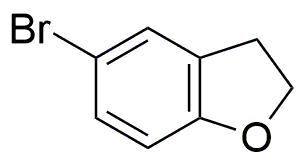5-Bromo-2,3-dihydrobenzofuran is widely utilized in research focused on:
- Synthetic Organic Chemistry: This compound serves as an important intermediate in the synthesis of various pharmaceuticals and agrochemicals, providing a versatile building block for creating complex molecular structures.
- Medicinal Chemistry: It is explored for its potential therapeutic properties, particularly in the development of new drugs targeting neurological disorders, due to its unique structural features that may influence biological activity.
- Material Science: Used in the formulation of advanced materials, this compound can enhance the properties of polymers and coatings, improving durability and performance in industrial applications.
- Biological Research: Researchers utilize it in studies examining the interactions of small molecules with biological systems, aiding in the understanding of cellular mechanisms and disease pathways.
- Environmental Chemistry: The compound is investigated for its role in the degradation of pollutants, contributing to the development of eco-friendly solutions for waste management and environmental remediation.
Informations générales
Propriétés
Sécurité et réglementation
Applications
5-Bromo-2,3-dihydrobenzofuran is widely utilized in research focused on:
- Synthetic Organic Chemistry: This compound serves as an important intermediate in the synthesis of various pharmaceuticals and agrochemicals, providing a versatile building block for creating complex molecular structures.
- Medicinal Chemistry: It is explored for its potential therapeutic properties, particularly in the development of new drugs targeting neurological disorders, due to its unique structural features that may influence biological activity.
- Material Science: Used in the formulation of advanced materials, this compound can enhance the properties of polymers and coatings, improving durability and performance in industrial applications.
- Biological Research: Researchers utilize it in studies examining the interactions of small molecules with biological systems, aiding in the understanding of cellular mechanisms and disease pathways.
- Environmental Chemistry: The compound is investigated for its role in the degradation of pollutants, contributing to the development of eco-friendly solutions for waste management and environmental remediation.
Documents
Fiches de données de sécurité (FDS)
La FDS fournit des informations de sécurité complètes sur la manipulation, le stockage et l’élimination du produit.
Spécifications du produit (PS)
Le PS fournit une description complète des propriétés du produit, notamment sa composition chimique, son état physique, sa pureté et les exigences de stockage. Il détaille également les plages de qualité acceptables et les applications prévues du produit.
Certificats d'analyse (COA)
Recherchez des certificats d'analyse (COA) en saisissant le numéro de lot du produit. Les numéros de lot et de lot se trouvent sur l'étiquette d'un produit, après les mots « Lot » ou « Lot de fabrication ».
Numéro de catalogue
Numéro de lot/série
Certificats d'origine (COO)
Ce certificat d'exploitation confirme le pays dans lequel le produit a été fabriqué, et détaille également les matériaux et composants utilisés et s'il est issu de sources naturelles, synthétiques ou autres sources spécifiques. Ce certificat peut être requis pour les douanes, le commerce et la conformité réglementaire.
Numéro de catalogue
Numéro de lot/série
Fiches de données de sécurité (FDS)
La FDS fournit des informations de sécurité complètes sur la manipulation, le stockage et l’élimination du produit.
DownloadSpécifications du produit (PS)
Le PS fournit une description complète des propriétés du produit, notamment sa composition chimique, son état physique, sa pureté et les exigences de stockage. Il détaille également les plages de qualité acceptables et les applications prévues du produit.
DownloadCertificats d'analyse (COA)
Recherchez des certificats d'analyse (COA) en saisissant le numéro de lot du produit. Les numéros de lot et de lot se trouvent sur l'étiquette d'un produit, après les mots « Lot » ou « Lot de fabrication ».
Numéro de catalogue
Numéro de lot/série
Certificats d'origine (COO)
Ce certificat d'exploitation confirme le pays dans lequel le produit a été fabriqué, et détaille également les matériaux et composants utilisés et s'il est issu de sources naturelles, synthétiques ou autres sources spécifiques. Ce certificat peut être requis pour les douanes, le commerce et la conformité réglementaire.


